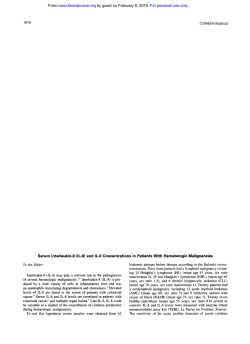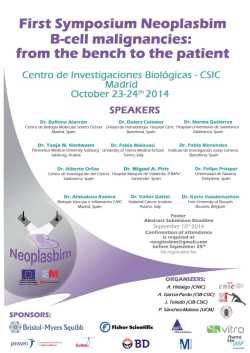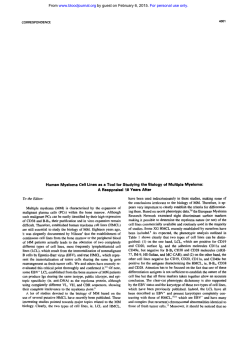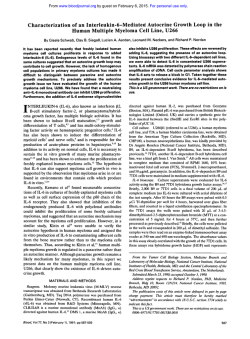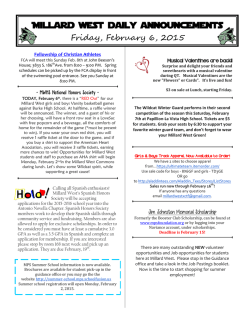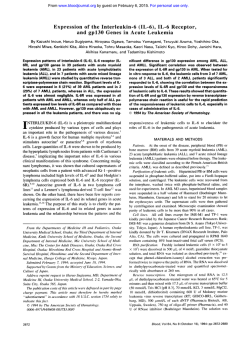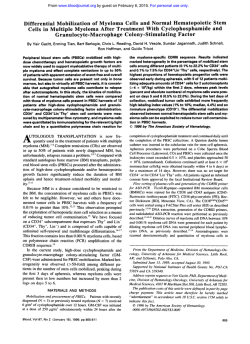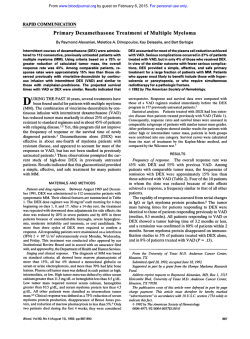
Anti-CD40 Antibody Binding Modulates Human Multiple
From www.bloodjournal.org by guest on February 6, 2015. For personal use only. Anti-CD40 Antibody Binding Modulates Human Multiple Myeloma Clonogenicity In Vitro By Alex W. Tong, Bing-qing Zhang, Gabriele Mues, Max Solano, Terrie Hanson, and Marvin J. Stone Ligand binding of theB-cell lineage antigen CD40 enhances growth and interleukin-6 (IL-6) secretion in human B cells (the CD40/11-6 loop). IL-6 has an autocrine and paracrine role in human multiplemyeloma (MM)cell growth. With the use of the CD40 monoclonal antibody (MoAb)G28-5, we examined CD40 expression and theeffect ofCD40 binding onMM clonogenic colony (MCC) formation t o characterize the IL-6/ CD40 loop activityin MM. CD40 was expressed on plasmacytoid cells in 21 of28 plasma cell dyscrasia (PCD) bone marrow (BM) biopsiestested ( I O of 14 MM, 2 of 2 Waldenstrom’s macroglobulinemia [WM], 2 of 2 plasma cell leukemia [PCL], 6 of 8 monoclonal gammopathy of undetermined significance IMGUSI, and 1 of 2 primary amyloidosis [ALII. G28-5 binding increased MCCs by 35% t o 150% in 11 of 17 CD40+ PCD BM cultures, but did not affect MCC formation in CD40specimens or normal BM colony forming units(CFU-GEMM, CFU-GM, BFU-E). Responsive cultures originated from BM of patients with MM (2 of 5 cases tested), WM (2 of 21,PCL (2 of 21, and MGUS (5 of 6). CD40-responsivenesswas not significantly inhibited by thepresence of an anti-IL-6 MoAb (2 of 2 MGUS cultures tested), and did not correlate with the capacity t o respond t o IL-6 stimulation (n = 17, P > .05) or a detectable level of endogenous IL-6 fn = 15, P > .05). Additional studies were performed with PCD cell lines t o characterize the interrelationship of CD40 activation and IL6 production. Fifty percent t o greater than 95% of cells from the RPM1 8226 and ARH77 lines expressed CD40, whereas 6% of U266 cells were CD40f. For RPM1 8226, ARH-77, and U266 cells, the increased MCC formation after anti-CD40 stimulation was notaffected by the presence of an anti-IL6 neutralizing MoAb and was not accompanied by detectable IL-6 secretion. There was no apparent increase in IL-6 mRNA transcription following G28-5 treatment of U266 or RPM1 8226 cells. Our observations indicate that CD40 is expressed in a subset of humanmyeloma cells present in various PCDs. Cell-line studies suggest that theCD40’ myeloma cell mayregulate MM clonogenic colony formation without activating theIL-6 pathway. 0 1994 by The American Society of Hematology. C human B cells and a murine lymphoma line transfected with the human CD40 gene.15 Conversely, binding of 1L-6 to the high affinity IL-6R (which is distinct from CD40) results in increased phosphorylation of CD40, which in turnstimulates IL-6 prod~ction.’~ This apparent interconnected signaling between IL-6 and CD40 led to the hypothesis of a “CD40/ IL-6 loop”, by which CD40 functions to receive and regulate IL-6-dependent signals in B cells.” At present, it is unclear whether CD40 plays a similar antiapoptotic role for malignant B cells or influences their autocrine IL-6 This issue is clinically relevant in MM, in view of the observations that MM disease progression may be affected by autocrine or paracrine action of IL-6.I6An elevated IL-6 serum level was correlated with MM disease ~everity,’”’~ and treatment with an anti-IL-6 MoAb produced a short-term remission in one plasma cell leukemia (PCL) patient.z” This study characterizes the distribution of CD40 in bone marrow (BM) samples from various PCD patients to explore the role of CD40 activation in IL-6-related growth modulation of MM. The relationship between CD40 activation and IL-6 production also was examined with MM cell lines for the purpose of characterizing activity of the CD40AL-6 loop. D40 IS A 277-amino acid type I membrane glycoprotein that is expressed on normal B cells but not on normal plasma cells.’,’ CD40 expression in human multiple myeloma (MM) has been shown in a limited number of cases,3” although the distribution of CD40 in other plasma cell dyscrasias (PCDs) has not been defined. CD40 was detected in human B leukemias and lymphomas,8-” where it was shown to be expressed on the clonogenic tumor subset.’ The natural ligand for CD40, termed gp39, is a type I1 transmembrane glycoprotein that is expressed transiently on activated T-helper cells.’.’2 Triggering of CD40 by gp39 or the CD40 monoclonal antibody (MoAb) G28-5 provides a costimulatory signal that rescues germinal center B cells from apoptosis and allows the resting B cell to proceed in the maturation p a t h ~ a y . ’ ~ Expression .’~ of both CD40 and the interleukin-6 receptor (IL-6R) is increased in activated B cells.15 (328-5 binding increased IL-6 secretion in normal From the Cancer Immunology Research Laboratory, Charles A. Summons CancerCenter,BaylorUniversityMedicalCenter, and the Mary C. Crowley Laboratory, Baylor ResearchInstitute, Dallas, m. Submitted January 18, 1994; accepted July 6, 1994. Supported in part by the Tri Delta Cancer Research Fundand the Edward and Ruth Wilkof Foundation. Presented in part at the 34th Annual Meeting of the American Society of Hematology, 1992, and the 85th Annual Meeting of the American Association for CancerResearch, San Francisco, CA, 1994. Address reprint requests to Alex W. Tong, PhD, Cancer Immunology Research Laboratory, Charles A.Summons Cancer Center,Buylor University Medical Center, 3500 Gaston Ave, Dallas, lX 75246. The publication costsof this article were defrayedin part by page chargepayment. This article must therefore be hereby marked “advertisement” in accordance with 18 U.S.C. section 1734 solely to indicate this fact. 0 1994 by The American Society of Hematology. 0006-4971/94/8409-0039$3.00/0 3026 MATERIALS AND METHODS Cell lines and antibody. The human MM-derived lines U266B 1 (EA) and RPM1 8226 (A light chain), the PCL line ARH-77 (GK) and the plasmacytoma-derived line HS-Sultan (GK)were obtained fromAmericanTypeCultureCollection. The MM-derived line GM1312 (GK)was obtained from the National Institute of General Medical Sciences Human Genetics Mutant Cell Repository,Institute of Medical Research (Camden,NJ). The CD40-reactive MoAb G285 was a generous gift from Dr J. Ledbetter (Bristol Myers Squibb, Seattle, WA). Recombinant human IL-6 was purchased from Promega (Madison, WI). Patient group. Primary BM cultures used marrow aspirates from patients with untreated MM (n = 22), MM in remission (n = 2). refractory MM (n = l ) , and relapsed MM (n = 1 ). We also cultured Blood, Vol 84, No 9 (November l ) , 1994: pp 3026-3033 From www.bloodjournal.org by guest on February 6, 2015. For personal use only. STIMULATION OF MYELOMA CLONOGENICITYVIA CD40 marrow aspirates of patients with monoclonal gammopathy of undetermined significance (MGUS) (n = 12), Waldenstrom’s macroglobulinemia (WM) (n = 3), and primary amyloidosis (AL) (n = 5 ) . Peripheral blood mononuclear cells with extensive myeloma involvement from 2 PCL patients also were used for MM clonogenic colony (MCC) assays. Diagnosis and classification of PCD were based on the criteria of clinical presentation, M-protein level in serum andor urine, presence or absence of lytic bone lesions, and histopathologic distribution of BM plasma cells.”~’’ BM aspirates were obtained during routine procedures for diagnosis or treatment. All BM samples were procured according to a protocol approved by the Institutional Review Board for Human Protection, Baylor University Medical Center. Immunoperoxidase staining protocol. (328-5 reactivity with PCD patient BM biopsies was determined by the immunoperoxidase technique as described previously.23Briefly, Zenker formalin-fixed, paraffin-embedded BMbiopsy sections were deparaffinized overnight, rehydrated, and treated with Lugol’s iodine and 5% sodium thiosulfate. The sections were washed in distilled water, then treated with 1% HzOzin absolute methanol and normal horse serum. Immunoperoxidase staining involved 60-minute incubations at room temperature withthe primary antibody, then secondary antibody (biotinylated horse anti-mouse IgG), followed by the enzyme avidin biotin-conjugated horseradish peroxidase (Vectastin ABC Elite kit; Vector Laboratories, Burlingame, CA) and substrate (0.02% 3amino-9-ethylcarbazole: 0.03% HzOz: 5% N,N-dimethylformamide). The sections were counterstained with Meyer’s hematoxylin. Reactivity was determined by light microscopy, in comparison with a section treated with the negative control MOPC21 mouse Ig. Plasmacytoid cells in each biopsy section were identified based on histopathologic features byan independent pathologist. Reactivity of (328-5 with plasmacytoid cells was confirmed by concomitant determinations with the myeloma cell-reactive MoAb MM4.23CD40 reactivity with each biopsy was graded as -: <5% reactive plasmacytoid cells; +: 5% to 25% reactive plasmacytoid cells; ++: 26% to 50% reactive plasmacytoid cells; + + +: >50% reactive plasmacytoid cells. MCC-forming assay. MCC-forming assay of MM cell lines was performed as previously de~cribed.’~ The number of clonogenic units in treated and untreated cultures was determined with a limiting dilution assay, using Spearman’s estimate. For culture of patient MCC, BM mononuclear cells were obtained by hypaque ficoll centrifugation (400g for 20 minutes) and resuspended in Iscove’s Modified Dulbecco Media (IMDM) at 4 X 106/mL.MCC cultures for PCL patients were established with hypaque-ficoll interphased peripheral blood mononuclear cells. One hundred-microliter aliquots of cells were dispensed to individual wells of a 24-well culture plate containing methylcellulose (40% vol/vol) in 20% fetal calf serum (FCS) and IMDM. Other culture conditions were tested, including variations of the double-layered agarose technique or the use of various culture s ~ p p l e m e n t s . ’These ~ ~ ~ ~conditions did not substantially improve the generation or yield of MCCs. Cells were incubated with or without IL-6 (0.5 to 5 ng/mL) and/or (328-5 (0.375 to 3.75 pg/ mL). Optimal concentrations of these reagents were established in cell line studies with U266 and RPMI 8226 cells. Tenfold increases in (328-5 or IL-6 concentrations did not significantly vary the level of stimulation for either cell lines (data not shown). The number of MCCs (>50 cells per colony) was counted by inverted microscopy at days 10 to 14. Determinations of the mean number of MCCs with or without added IL-6 or G28-5 were based on triplicate determinations, with intrareplicate variations of 0% to 15%. An increase of 35% or greater in the meannumber of MCCs was arbitrarily considered as a significant response. The role of IL-6 in MCC stimulation was determined by coincubation with a blocking concentration (7.5 3027 pg/mL) of an anti-human IL-6 neutralizing MoAb (R & D Systems, Minneapolis, MN). Flow cytometric analysis. Surface antigen expression of MM cells was determined by single color or dual color flow cytometric immunofluorescence as described p r e v i o ~ s l y .Briefly, ~~ myeloma cells were harvested at logarithmic growth, washed twice, and resuspended at 2 X 107/mL inphosphate buffered saline (PBS). Incubation (4°C for 30 minutes) was carried out with (328-5, followed by a fluorescein-conjugated goat anti-mouse Ig antibody (FITC-GaMIg; from Tag0 Inc, Burlingame, CA) with appropriate washings. The reactants were then incubated with phycoerythrin (PE)-conjugated MoAbs to surface Ig (sIg), CD10, CD19, CD56, or CD38 with appropriate washings. The CD10 MoAb (J5; Coulter Immunology, Hialeah, F‘L) reacts with the common acute lymphocytic leukemia antigen (CALLA) that is expressed in non-T acute lymphocytic leukemias (ALL), lymphomas, and some chronic myelogenous leukemia (CML) blast crisis patients. The CD19 MoAb (BWclone 89B, Coulter) defines a 90- to 95-kD antigen that is present in early and mature B cells and expressed on non-T ALL and some CML blast crisis cells. The CD56 MoAb ( N W - l , Coulter) recognizes a human natural killer (NK) cell antigen of 200 to 220 kD that is expressed in subpopulations of large granular lymphocytes with NK activity. The CD38 MoAb (Leu-l7/HB7, Becton Dickinson, Mountain View, CA) reacts with most B cells, subsets of T cells and monocytes, and most NK cells. Expression of these CD antigens on human myeloma cells has been documented previ~usly!.~ Single-color immunophenotyping analysis was carried out concomitantly using G28-5 and FITC-GaMIg, or individual PE-MoAbs alone. Unconjugated MOPC21 mouse Ig (Cappel Laboratories, Cochranville, PA) + FITC GaMIg and isotype matched PE-conjugate of irrelevant mouse Ig (Coulter) were used to establish background fluorescence. Immunofluorescence was determined by the Ortho 50H Cytofluorograf (Ortho Diagnostics, Raritan, NJ). Green-emitting, red-emitting, and dual fluorescent subsets were discriminated by software-driven computer analysis (Ortho 2151) of 5,000 events. IL-6R expression was determined byflow cytometric analysis with the recombinant human [r(h)] IL-6 Fluorokine kit (R & D Systems), based on cell binding with PE-conjugated r(h)-IL-6. The frequency of expression of ILdR on the U266, ARH-77, GM1312, and RPMI 8226 cell lines was 46%, 6%, 3%. and 2%, respectively, after background correction. QuantiJcarion 0flL-6. Quantification of IL-6 was performed by an enzyme-linked immunosorbence assay with anti-IL-6 antibodycoated microtiter plates (R & D Systems) as described previo~sly.~ MGUS, and AL patients was deterIL-6 level in BM of MM, W , mined with BMsupernatant fluids after pelleting of patient BM cells (200g for 10 minutes). The IL-6 level of PCL patients was determined with plasma after pelleting of peripheral blood cells (200s for 10 minutes). The threshold of detection ( 2 3 pg/mL) is within the same order of magnitude as proliferative assays withIL-6dependent cell lines (-2 ~g/mL).’~ All normal subjects tested had less than the detectable level of IL-6 ( 2 3 pg/mL) in BM (n = 15). MCC culture media and FCS were prescreened and did not contain a detectable level of IL-6. The IL-6 level of MCC cultures following (328-5 incubation could not be determined because of the requirement of methylcellulose in MCC culture media. Reversetranscriptionpolymerasechainreaction(RT-PCR). Semiquantitative determination of cellular IL-6 mRNA was canied out by the PCR reaction, using MM cell cDNA synthesized by RT. MM cells were cultured with or without (328-5 for 48 hours. Our earlier 3H-thymidine uptake studies showed an increased proliferation by (328-5 in the same culture p e r i ~ dCellular .~ RNA was extracted from equal numbers of cells by the guanidine isothiocyanate/acid phenolchloroform method?’ Total RNA was annealed to an IL-6 specific 3’ primer and reverse transcribed with M-MLV reverse transcriptase From www.bloodjournal.org by guest on February 6, 2015. For personal use only. 3028 TONG ET AL (GeneAmp RNA PCR kit; Perkin Elmer Cetus, Norwalk, CT). The Table 1. CD40 Expression in PCD Patients reverse-transcription products and PCR reagents were kept at the Disease Status*/ Percent PC 5' primer-annealing temperature before mixing and addition of the (isotype)t Patient Name (23mer) and 3' (22mer) oligodeoxynucleotide primers that flank MM§ nucleotides 57-639 of the mature IL-6 message (Human IL-6 Ampli1. AS 35 (KLCD) mer Set; Clontech Lab, Palo Alto, CA). Amplification was camed 2. RE 30 (GA) out with Taq polymerase and a Perkin Elmer-Cetus Thermocycler 3. BC 90 ( G K ) (denaturing: 94"C, 1 minute; annealing: 5.5" or 6 0 T , 45 seconds; 4. LE 35 (KLCD) elongation: 7 2 T , 45 seconds; 35 cycles). Amplified DNA of the 5. MV 35 ( G K ) expected size (628 bp) was identified following agarose (1 S % ) elec6. TW 10 (GM trophoresis and ethidium bromide staining, Internal standards in7. DS 95 (GK) cluded concomitant RT and amplification of mRNA for the heat 8. MW 20 (GA) shock cognate protein HSC70, a constitutively expressed molecular 9. BC 90 (DM chaperone,'" and p-actin mRNA. Equivalent levels of amplified 10. WB 30 (GK) HSC70 cDNA or p-actin cDNA in treated and untreated samples 90 JB 11. (GK) indicated that the source of amplified IL-6 cDNA from G28-5-treated 12. JS 80 ( G K ) and untreated samples was derived from equivalent amounts of total 45 RNA 13. TC (GK) cellular RNA. The use of equal amounts and quality of total 14. RC 21 (KLCD) could be further shown by gel electrophoresis of the RNA samples. WM 20 (MK) 15. KA RESULTS 16. DP 2 (MA) CD40 expression in PCD BM biopsies. Previous studies have carried out limited determinations of CD40 expression in MM and PCL BM.'" In this study, we examined CD40 expression in 28 patient BM biopsies from MM, PCL, as well as other PCDs, using the MoAb G28-5 and the immunoperoxidase technique. Clinical diagnosis, the frequency distribution of plasma cells and their isotype of each case are shown in Table 1. Twenty-one of the 28 PCD cases tested contained 2 5 % of G28-S-reactive plasmacytoid cells (Table 1). CD40 was expressed in >25% (++) of plasmacytoid cells in 6 of 14 MM cases, 2 of 2 PCL cases, 1 of 2 cases of WM, and 1 of 7 cases of MGUS tested. One of 2 cases of AL amyloid had low CD40 expression (Table 1). No G285 reactivity was evident with BM granulocytic and erythroid 10 WJ components. These observations indicate that CD40 was expressed on plasma cells from various PCDs. Effect of anti-CD40 MoAb binding on MCC formation. In vitro MCC forming cells maybe closely related to the MC stem cells in The pathophysiologic role of CD40 activation inhuman MM cell growth was explored by examining the effect of G28-5 incubation on MCC formation of PCD patient primary BM cultures. MCCs wereidentified by their colony morphology, which is distinct from normal BM-CFUs, and by identification of cells with plasmacytoid features following Wright-Giemsa staining.?," The plasmacytic nature of MCCs was confirmed by their expression of the relevant cytoplasmic monoclonal light chain as determined by immunohistology and confirmation of Ig-heavy chain utilization by PCR with culture-harvested MCCs (n = 7). Seventeen of 24 PCD BM specimens tested cocomitantly for CD40 expression andMCC formation had a positive MCC culture, including 15 of 22 cases of primary BM cultures and 2 of 2 PCL peripheral blood cultures (Table 2). With intrareplicate variations that ranged from 0% to 15% (triplicate determinations), a 235% increase in the mean number of MCC was arbitrarily considered as a significant response. Eleven of the 17 (65%) MCC+-cultures had a 235% increase in myeloma MCCs following treatment with (328-5 (Table 2). Responders included BM specimens from CD40 Expression* ++ i ~ + + ~ +++ t i ~ ++ + +t ~ +t + ++ PCL 17. JM 18. DC 95 ( G K ) 68 (ALCD) ++ t++ MGUS 19. CD 20. NS 2 (GK) 5 (GK) 21. MH 22. FD 4 (AA) 3 (GM 6 (GM 23. 24. 25. 26. SO CB + ~ + + ++ + HL 6 (GA) 7 (ALCD) IJ 9 (GK) - 4 (ALCD) - (ALCD) + + AL 27. HH 28. *At the time of analysis, based on laboratory and clinical criteria. t Percentage PC = YO plasma cell in BM as determined by histopathology except for patients 20 and 21, where the %PC represents the % plasma cells in peripheral blood; M protein isotype was determined by serum and urine protein immunofixation. Frequency of CD40' plasmacytoid cells a s determined by the imrnunoperoxidase technique with Zenker-fixedBM biopsy sections and G28-5 (15 pg/mL). -: <5% reactive plasmacytoid cells; +: 5% to 25% reactive plasmacytoid cells; ++: 26% to 50% reactive plasmacytoid celels; +++: >50% reactive plasmacytoid cells. § All MM pts were untreated at thetime of analysis, with the exception ofTC who had relapsed disease. * 2 of 5 cases of MM, 5 of 6 MGUS, 2 of 2 WM, and peripheral blood cultures from 2 of 2 PCL cases. All 11 G28-5-responsive cultures originated from BM with 2 5 % CD40' plasmacytoid cells. Six of the 11 responder cultures (compared with 3 of the 7 nonresponder cultures) had greater than 25% CD40' plasmacytoid cells. Treatment with the same concentration of an isotype-matched irrelevant monoclonal mouse Ig (MOPC-21) did not affect MCC growth. Conversely, G28-5 did not affect the level of normal BM colony-forming cells (CFU-GM, BFU-E, CFU-GEMM; n = 3). Regression analyses indicated that the frequency of CD40' myeloma cells was correlated with the percentage of plasmacytosis in BM specimens examined (Fig lA, P = .04, From www.bloodjournal.org by guest on February 6, 2015. For personal use only. STIMULATION OF MYELOMACLONOGENICITYVIA 3029 CD40 Table 2. Stimulation of MCCs of PCD Patient Primery BM Cultures by 11-6 and 628-5 No. MM-CFUst Disease Status'/ Patient Name MM MW W0 JS TC RC DS JB RW WM KA DP PCL JM DC MGUS NS MH FD so CB HL VJ EW IJ AL HH WJ nw IL-6 Concentration* No G28.5 +G28.5 +L6 (pg/mL) 45 985 37 44 61§ 54 738 35 49 62 § 0 0 0 0 0 0 0 0 11 <3 189 <3 NT <3 NT 13 51 82 1135 1656 45 85 3 <3 41 280 1015 390§ 775 3149 86 88 134 21 48 82 18 68 138 31 § 101§ 1349 295 (28)l' 925 (98) 135 23 40 84 25§ (17) 66 (72) NT 52 62 31 44 44 0 0 0 31 28 0 0 6 0 0 0 0 0 0 106 13 <3 6 <3 13 13 36 35 0 35 26 0 <3 <3 <3 Abbreviation: NT, not tested. * A t the time of analysis, based on laboratory and clinical criteria. t The number of myeloma clonogenic colonies (>50 cells per colony) was counted by inverted microscopy at days 10-14. Determinations of the mean number of MCCs with or without added G28-5 were based on triplicate determinations, with intrareplicate variations of 0% to 15%. Determined by ELSA with ananti-IL-6 MoAb (see Materials and Methods). 5 Increase of 235% over untreated control sample. 11 ( ): No. of MCCs of parallel cultures coincubated with an anti-IL6 neutralizing MoAb added at day 0. * r = .4, n = 28). However, the magnitude of increase in MCC following anti-CD40 stimulation ofMCC' cultures was not proportional to the frequency of CD40+ myeloma cells (Fig lB, P > .05, r = .2, n = 17) or disease status. BM biopsies from 7 PCD patients that did not produce MCCs were examined retrospectively for CD40 expression. Six of these patients (DS, JB, RW, EW, IJ, HW) expressed CD40, with 3 of the 6 specimens (DS, EW, HW) containing 225% CD40+ myeloma cells (data not shown). These observations suggest that CD40 expression may not be the limiting determinant of MM clonogenic potential in vitro, and that only a subset ofCD40'MM cells maybe involved in MCC formation. Role of IL-6in MCC stimulation. The effect of IL-6 on MCC formation was compared with that of (328-5 to explore the relationship between IL-6 and anti-CD40 MoAb-mediated MCC stimulation. MCC formation did not appear to depend on the presence of endogenous IL-6 ( P > .05), which was detected in 7 of 21 uncultured BM and peripheral blood specimens (MM, 2 of 6 cases; WM, 0 of 2 cases; PCL, 2 of 2 cases; MGUS, 3 of 8 cases; Table 2). Exogenous IL-6-enhanced MCC formation ( 2 3 5 % ) in 5 of 17 BM and peripheral blood primary cultures tested (2 of 5 MM, 2 of 2 PCL, and 1 of 6 MGUS; Table 2). All 5 IL6-responsive cultures also responded to (328-5 stimulation. However, responsiveness to anti-CD40 MoAb stimulation of MCC' cultures did not correlate with IL-6 responsiveness ( P = .07, Fisher's exact test, n = 17) or a detectable IL-6 level ( P > S , Fisher's exact test, n = 15). In two MGUS primary BM cultures tested so far, cotreatment with a neutralizing anti-IL-6 MoAb abrogated the IL6-enhanced MCC response (patient CB) but did not affect the stimulatory effect of (328-5 (CB and HL, Table 2). Our observations suggest that anti-CD40 stimulation of MCC formation may not require an active IL-6 pathway. G28-5 and IL-6stimulation of human MM cell lines. Established PCD cell lines were used to better define the interrelationship of MCC activation by (328-5 and IL-6 binding. Five of five PCD cell lines tested contained CD40' myeloma cells (Table 3). The CD40+ subset coexpressed CD10, CD19, CD38, CD56, and sIg (Table 3). The low number of CD40' U266 cells also coexpressed the IL-6R. By comparison, 50% or greater of RPMI 8226, ARH-77, and GM13 12 myeloma cells expressed CD40, of which only a minority expressed the IL-6R (Table 3). We examined the effect of(328-5 and IL-6 binding on MCC formation of RPMI 8226 and ARH-77 cell lines, with U266 cells serving as reciprocal negative control (Table 4). Both RPMI 8226 and ARH-77 cells had a doubling of MCCs (102% and 128% increase, respectively; P < .05) following G28-5 treatment, which affected U266 MCC formation only moderately (22%; P < .05; Table 4). By comparison, IL-6 did not significantly increase MCC formation of RPMI 8226 or ARH-77 cells ( P > .OS), whereas the level of IL-6stimulated U266 MCCs was 2.4-fold that of unstimulated cultures (139%, P < .001) (Table 4). Coincubation with an anti-IL-6 MoAb did not affect the baseline level of U266 MCC formation, but was effective in eliminating 75% of the increased MCC response by IL-6 (Table 4). By comparison, anti-IL-6 MoAb treatment did not significantly alter the G28-5-stimulated MCC level in U266, RPMI 8226, and ARH-77 cultures (Table 4). These observations suggest that MCC stimulation by G28-5 was independent of secretable IL-6. Characterization of IL-6secretion and IL-6mRNA. To define the activity of the CD40/IL-6 loop, we examined cell culture IL-6 levels with the high responders RPMI 8226, ARH-77 and low responder U266 cells. Cells were cultured for 48 hours, which we found previously to be appropriate for generating an enhanced 3H-thymidine uptake response by C128-5.~The IL-6 level in culture supernatants of all three cell lines was below the threshold of detection ( 2 3 pg/mL) before and after incubation with(328-5 (data not shown). From www.bloodjournal.org by guest on February 6, 2015. For personal use only. 3030 TONG ET AL . . A 100 l I . 75 .G -I B A e I 150 A 125 B MGUS 0 0 m 100 Fig 1. Correlation freof quency of CD40 myeloma cells with percent plasmacytosis and increase inMCCformation.(A) Frequency distribution of CD40' plasma cells versus percent of plasmacytosis in BM of patients with MM 101, W M M , PCL (AI, MGUS (01. or AL amyloidosis In).(B) Freauencv distribution of CD40' plasma cells in each B M specimen and its corresponding MCC response after G28-5 stimdation. 75 8 0 50 0 A. 0 25 0 A . o 5%-25% DISCUSSION Our study showed that CD40 was expressed on human myeloma cells in BM of patients with various PCDs. PreviTable 3. CD40 Expression in Human MM Cell Lines % Reactivity* CD40 CD10 11 CD56 slg 95 44 252 33 21 14 2 CD19 CD38 <l <l IL-6R 20 3 24 3 33 39 3 2 34 2 46 6 16 17 62 53 14 14 <1 <l NT NT 6 5 88 <l <1 NT NT NT NT NT NT NT NT 3 3 >9588 84 82 NT NT NT NT NT NT I Frequency of CD40+ cells The effect of CD40 binding on IL-6 transcription was further evaluated by RT-PCR with U266 and RPMI 8226 cells. For RPMI 8226, IL-6 cDNA was not detected before (Fig 2, lane 8) or after (328-5 incubation (lane S), indicating that IL-6 mRNA was either absent or remained at below the level of PCR detection following anti-CD40 stimulation. IL-6 mRNA expression in U266 cells was successfully established, based on identification of amplification products of the expected size (628 bp) with IL-6 primers (Fig 2, lane 4). There was noapparent increase in the level ofIL-6 amplification product from RNA of U266 cells that were cultured in presence of G28-5 (lane 5). These findings suggest that anti-CD40 stimulation of MCC was not accompanied by an increased IL-6 transcription. Cell Line T T W% 5%-25% 26%-50% >50% Frequency of CD40+ cells RPM1 8226 50 % reactive cells 6 50 % CD40' U266 % reactive cells 6 % CD40' 6 ARH-77 % reactive cells >95 >95 % CD40' HS-Sultan % reactive cells 90 94 % CD40' 94 G M 1312 80 % reactive cells 80 % CD40' - A I * Determined by flow cytometric analysis and theindirect immunofluorescence technique with G28-5 and FITC-Gamlg and PE-conjugated MoAbs to CD10, CD19, CD38, CD56, and slg (see Materials and Methods). >"% . . ous determinations of CD40 expression in PCD wererestricted to limited numbers of PCL and MM cases. Hamilton et ai4 showed that CD40 was expressed on approximately 40% of myeloma cells in 1 of 2 PCL patients tested, whereas 2 of 2 myeloma cases did not contain CD40'myeloma cells. Jackson et a15 described weak to moderate cytoplasmic staining of CD40 in myeloma plasma cells of 4 of 7 patients. Two of 16 patient samples showed weak surface membrane expression.' By comparison, the recent studies by Westendorf et al' and Bakkus et al' showed CD40 expression on myeloma cells from 7 of 7 and 10 of 10 MM specimens, respectively. Our study showed that 75% of the 28 cases of PCD BM tested contained CD40' myeloma cells, based on immunohistochemical analysis. G28-5 reactivitywith patients having MGUS, as well as AL-amyloidosis, WM, MM, and PCL indicates that the CD40' myeloma cell is present in asymptomatic as well as overtly malignant PCDs. With the exception of the 2 cases of AL-amyloidosis BM tested, each of other PCD clinical subsets encompassed specimens with a high frequency of CD40' myeloma cells. Heterogeneity of CD40 expression was evident within individual myeloma cell populations. (328-5 reactivity ranged from 5% to greater than 90% of total plasmacytoid cells in BM specimens tested. This heterogeneity was also manifested in a difference in CD40 antigenic density on individ- Table 4. MCC Formation After Treatment With IL-6 and 628-5 Treatment G28-5 IL-6 IpgImL) (ngImL) 0.375 0.375 None None None None 5 5 % Increase in MCC' Anti-IL-6 MoAb (pgIrnL) None 7.5 None 7.5 U266 22 22 139 35 2 8t 2 17t t 27t t 20t RPM1 8226 102 2 30t 96 t 18t 11 4 6 5 11 ARH-77 128 91 5 14 t 46t 2 36t 2 5 t 14 * Based on comparison of MM clonogenic units in treated with untreated control. M M clonogenic units were determined by Spearman's estimate and the limiting dilution clonogenic assay. Values represent mean 2 SEM; n = 4 to 8. t F' < .05 compared with untreated cultures. From www.bloodjournal.org by guest on February 6, 2015. For personal use only. STIMULATION OF MYELOMA CLONOGENICITYVIACD40 1 2 3 4 5 6 7 89101112 Fig2.RT PCR of IL-6 mRNA. The PCR reaction was performed with RT-generated cDNA from U266 (lanes 2 through 5) and RPM1 8226 cells (lanes8 through 111. Thirty-five cycles ofamplificationwas performed with Taq polymerase inpresenceof 5' (23mer) and 3' (22merl oligodeoxynucleotideprimers that flank nucleotide 57-639 of the mature IL-6-message and RT products from untreated (lanes 4 and 8 ) and G28-5-treated (lanes 5.9) cells. Amplified DNA products were identified after agarose (1.5%) electrophoresis and ethidium bromide staining.Parallel evaluations of the constitutive p-actin mRNA showed that evaluations of paired untreated and G28-5treated samples originated from equivalent amounts of cellular RNA (U266: lanes 2.3; RPM1 8226, lanes 10,111. Lanes 1,12: DNA size standards; lane 2: U266 cells, untreated, with p-actinprimers;lane 3: U266 cells 628-5, withp-actin primers; lane 4 U266 cells, untreated, with IL-6 primers; lane 5: U266 cells + 628-5, with 11-6 primers; lane 6 IL6 primers without cellular cDNA; lane 7: IL-6 primers in presence of commercially purchasedIL-6cDNA; lane 8 RPM1 8226 cells, untreated, with IL-6 primers; lane 9: RPM1 8226 cells + G28-5, with IL6 primers; lane 1 0 RPM1 8226 cells, untreated, with p-actinprimers; lane 11: RPM1 8226 cells 628-5, with p-actin primers. The position correspondingto the expected amplified productsfor 11-6 mRNA (628 bp) is indicated at the right margin. + + ualMM cells, as reflectedby variations in immunohistochemical staining intensity. The presence of low antigenic density CD40' myeloma cells may account for the low number of MM positives detected by Hamilton et al' and Jackson et als in their limited evaluation by the indirect immunorosette technique. By using themore sensitive subset flow cytometric analysis and gold-silver immunohistochemistry techniques, Westerndorf et alh and Bakkus et al' detected a higher frequency of CD40+ MM cells. By the same reasoning, our routine avidin-biotin immunoperoxidase analysis may underestimate the frequency of CD40' PCDs that are comprised of small numbers of myeloma cells withlow CD40 antigen density. Dual color flow cytometric analysis with MM cell lines indicated that phenotypic heterogeneity exists within the CD40' myeloma population, which coexpresses CDIO, CD19, CD38, and/or CDS6. Unlike normal activated B cells, the IL-6RTD40' cell constituted only a minor portion of each of the MM cell line populations. Our ohservation of an enhanced MCC response following G28-5 treatment indicates that the CD40 pathway is functionally active in patient myeloma cells. For normal resting B cells, interaction of CD40 with its natural T-cell ligand Gp39'.'* provides a second signal for normal resting B cells that leads to polyclonal B-cell activation' and heavy chain switching.''.'* It is presently unclear whether CD40 serves a similar antiapoptotic role for cell activation in hematologic 3031 malignancies. Uckun et alx showed that CD40 is expressed on the clonogenic subset of human B lymphocytic leukemias and lymphomas. Various reports indicated that CD40 stimulation by its MoAb or a synthetic ligand may stimulate,"." inhibit,"' or had no effect"' on human B-cell lymphoma cell growth. The generation of an optimal growth-inhibitory signal onhuman lymphoma cell lines required the artificial MoAb cross-linking before the binding of CD40.'" By contrast, soluble anti-CD40 MoAb and IL-4-stimulated the proliferation of tumor cells isolated from follicular lymphoma patients? Similar conditions also promoted 'H-thymidine uptake of leukemia cell clones derived from S of 7 B-chronic lymphocytic leukemia patients, but poorly stimulated their differentiation into Ig-secreting ceIk3' An enhanced 'H-thymidine uptake following CD40 binding alone has been previously described by us and others with the RPMI 8226 line' andthe IL-6-dependent myeloma line ANBL-6." In this study, approximately 65% of CD40' PCD BM cultures had increased MCC formation following (328-5 binding. This assessment may represent an underestimation of CD40 responsiveness because variations in the MCC assay limit the definition of a positive response to increases of 35% or higher. The 1 I G28-5-responsive cases were comprised of specimens from MM, PCL, as well as MGUS, WM, and AL amyloidosis patients. These findings provide indirect evidence that the clonogenic subset of monoclonal plasma cells expresses CD40, which may remain active in pathways that regulate myeloma cell proliferation and MCC formation in benign as well as malignant forms of PCD. The limited number of cases analyzed precludes definitive comparisons on the relative frequency of CD40-responsiveness in each PCD clinical subset. According to Clark and Shu," CD40 may function to receive and regulate IL-6-dependent activation signals in B cells (the CD40/IL-6 loop). The CD40/IL-6 loop does not appear to be the predominant mechanism of CD40-mediated MCC stimulation in patient primary BM cultures. Only 7 of 15 MCC' patients primary BM cultures had detectable IL6 before culture, indicating that MCC formation wasnot dependent on the presence of IL-6. Furthermore, responsiveness to (328-5 stimulation was not correlated with IL-6 responsiveness nor with a preexisting detectable level of IL6. Coincubation with a neutralizing anti-IL-6 MoAb also didnot affect the anti-CD40 stimulated MCC response in two MGUS patient primary BM cultures tested. These observations suggest that enhancement ofMCC formation via the IL-6R and CD40 may use distinct activation pathways. Additional evaluations with MM cell lines support this premise. For RPM1 8226 andARH-77 cells, the doubling of MCCs by G28-5 didnot produce detectable levels of the IL-6 protein. There was no detectable IL-6 transcription in unstimulated and(328-S-stimulatedRPMI 8226 ccll cultures. For U266 cells that actively transcribed IL-6, there was no apparent increase in IL-6 mRNAlevel in G28-Sstimulated cultures. These observations argue against the possibility that 1L-6 may be produced as a consequence of anti-CD40 MoAb binding andused autocritically without secretion." Finally, cotreatment withan anti-lL-6 MoAb, which eliminated the majority of the MCC-enhancing effect From www.bloodjournal.org by guest on February 6, 2015. For personal use only. 3032 of exogenous IL-6 on U266 cells, was ineffective in altering the MCC stimulatory response of G28-5 for RPMI 8226, ARH-77, or U266 cells. Our findings differed from those with the IL-6-dependent MM line ANBL-6, which responded to CD40activation with an enhanced growth pattern and increased IL-6 mRNA production andcytokine secretion.h UnlikeARH-77,RPMI 8226, and U266 cells, whose growth is independent of exogenous IL-6,the anti-CD40growth stimulatoryeffect on ANBL-6 was partially blocked by an anti-IL-6 MoAb. This difference may reflect use of distinct CD40 signaling pathalso difways,as IL-6-growth-dependentmyelomacells fered from their IL-6-nonresponding counterparts in terms of receptor expression, cytokine secretion, and disease aggressiveness.’7,34 For IL-6-dependent hybridoma cells, IL-6 gene expression and signaling involves a common pathway with tyrosine phosphorylation of a 160-!dl protein (p160) and activation of a protein kinase that is distinct from phosphokinase C and phosphokinase A. Thispathway appears to be independent of phosphotidyl inositol turnover and Ca++ ion in flu^.'^,'^ By comparison, signaling via CD40 in normal B cells results in tyrosine phosphorylation that depends on phosphotidyl inositol and C a + + t u r n o ~ e r . ”Further ~ ’ ~ evaluations of these activationpathways will be useful in characterizing the interplay of IL-6R and CD40 in IL-6-growth-dependent and independent MM. Multivariate analysis of CD40 expression and MCC responsivenesssuggests that variables inaddition toCD40 expression may be involved in CD40-mediated MCC formation and/or its regulation: CD40+ myeloma cells were detected in both MCC+ and MCC- patient primary BM cultures, and the magnitude of MCC stimulation by G28-5 did not correspond to the frequency of CD40’ myeloma cells before culture. Our findings of heterogeneity of the CD40 myeloma cell with respect to phenotype and CD40antigenic density suggest that MCC formation and its regulation may engender a finite subset of these CD40’ myeloma cells. Additional factors may also contributetowards an optimalMCC response, such as cytokines other than IL-6 that may serve anautocritic or paracritic role in promotingmalignant Bcell or myeloma-cell g r ~ w t h . ’ ’ ~ Further ~ ’ ~ ~ ~ studies in these areas may help define the pathophysiologic role of CD40 in the growth maintenance and disease progression of patients with various PCDs. TONG ET AL 3. TongAW,HansonT,Zhang B, StoneMJ:Stimulation of human multiple myeloma clonogenic colonies by a monoclonal antibody to the B lineage antigen CD40. Blood 80:124a, 1992 (suppl I) 4. Hamilton MS, Ball J, Bromidge E, Franklin IM: Specific antigen expression of human neoplastic plasma cells includes molecules associated with lymphocyte recirculation and adhesion. BrJ Haemato1 78:60, 1992 S. Jackson N, Ling NR, Ball J, BromidgeE, Nathan PD, Franklin 1M: An analysis of myeloma plasma cell phenotypeusing antibodies defined at the IIIrd international workshop on human leucocyte differentiation antigens. Clin Exp Immunol 72:3.51, 1988 6. Westendorf JJ, Ahmann GJ, Armitage RI, Spriggs MK, Lust JA, Greipp PR, Katzman JA, Jeniek D F CD40 expression in malignant plasma cells. Role in stimulation of autocrine secretion by a human myeloma cell line. J Immunol 152:l 17, 1994 7. Bakkus MHC, Riet IV, De Greef C, de Boer M, Thielemans K, Van Camp B: Expression of activation molecules (CD40. B7 and IV International CD28) in humanmultiplemyeloma.Proceedings WorkshoponMultipleMyeloma,Rochester,MN,Mayo Medical Center,1993,127 8. Uckun FM, Gajil-Peczalska K, Myers DE, Jaszca W, Haissig S, Ledbetter JA: Temporal association of CD40 antigen expression with discrete stages of human B-cell ontogeny and the efficacy of anti-CD40 immunotoxins against clonogenic B-lineage acute lymphoblastic leukemia as well as B-lineage non-Hodgkin’s lymphoma cells. Blood 76:2449, 1990 9. Johnson PWM, Watt SM, Betts DR, Davies D, Jordan S . Norton AJ. Lister TA: Isolated follicular lymphoma cells are resistant be grown in vitro intheCD40/stromalcell toapoptosisandcan system. Blood 82:1848, 1993 IO. Funakoshi S, Longo DL, Beckwith M, Conky DK, Tsarfaty G , Tsarfaty I, Armitage M,Fanslow WC, Spriggs MK, Murphy WJ: Inhibition of human B-cell lymphoma growth by CD40 stimulation. Blood83:2787,1994 I I . Holder MJ, Wang H, Milner AE, Casamayor M, Armitage R, Spriggs MK, Fanslow WC, MacLennan ICM, Gregory CD. Gordon J: Suppression of apoptosis in normal and neoplastic human B lymphocytes by CD40 ligand is independent of Bcl-2 induction.Eur J Immunol 23:2368, 1993 12. Hollenbaugh D, Grosmaire LS, Kullas CD, Jan Chalupny N. Braesch-Andersen S, Noelle RJ, Stamenkovic I, Ledbetter JA and Aruffo A: The human T cell antigen gp39, a member of the TNF genefamily, is a ligandfortheCD40receptor:Expression of a soluble form of gp39 with B cell co-stimulatory activity. EMBO J 11:4313, 1992 13. Liu YJ, Joshua DE, Williams GT, Smith CA, Gordon J, MacLennanICM:Mechanismofantigen-drivenselectioningerminal centres. Nature 342:929, 1989 14. Splawski JB, Fu SM, Lipsky PE: Immunoregulatory role of CD40 in human B cell differentiation. J Immunol 150:1276, 1993 ACKNOWLEDGMENT IS. Clark EA, Shu G: Association between IL-6 and CD40 signalThe authors express their appreciation to the staff of the DepartJ lmmunol ing. IL-6 inducesphosphorylationofCD40receptors. ment of Pathology, Baylor University Medical Center, for their assis- 145:1400,1990 tance in procurement and histopathologic evaluation of patient BM 16. Kawano M, Hirano T, Matsuda T, Taga T, Horii Y, lwato K, samples, and to Drs Virginia Pascual and J. Donald Capra, UniversityAsaoku H, Tang B, Tanabe 0, Tanaka H, Kuramoto A, Kishimoto of Texas Southwestern Medical Center, Dallas, for the characterizaT: Autocrine generation and requirement of BSF-2/IL-6 for human tion of VHgene family utilization in patient MCC samples by PCR. multiple myeloma. Nature 332:83, 1988 17.Bataille R, Klein B: Serumlevels of beta-2microglobulin REFERENCES and interleukin-6 to differentiate monoclonal gammopathy of undetermined significance. Blood 80:2433, 1992 1. Clark EA, Ledbetter JA: Structure, function, and genetics of 18. Ludwig H, NachbaurDM,Fritz E, KrainerM,Huber H: human B cell-associated surface molecules. Adv Cancer Res S2:81, Interleukin-6 is aprognosticfactorinmultiplemyeloma. Blood 1989 77:2794, 1991 2. Noelle RJ, Ledbetter JA, Aruffo A: CD40 and its ligand, an S, Gandolfo G , essential ligand-receptor pair for thymus dependent B-cell activation. 19. GrecoC, Citelli G, CianciulliA,Alvino Ameglio F: Are serum interleukin-6 levels always useful in differImmunol Today 13:427, 1992 From www.bloodjournal.org by guest on February 6, 2015. For personal use only. STIMULATION OF MYELOMA CLONOGENICITY VIA CD40 entiating monoclonal gammopathies in unselected pts? Blood 79:2173, 1992 20.Klein B, Wijdenes J, Zhang ZG, Jourdan M, Boiron JM, Brochier J, Liautard J, Merlin M, Clement C, Morel-Foumier B, Lu ZY, Mannoni P, Sany J, Bataille R: Murine anti-interleukin-6 monoclonal antibody therapy for a patient with plasma cell leukemia. Blood 78:1198, 1991 21. Stone MJ: Monoclonal gammopathies: Clinical aspects, in Ritzmann SE (ed): Pathology of Immunoglobulins: Diagnostic and Clinical Aspects. Protein Abnormalities, v01 2. New York, NY, Liss, 1982, p 161 22. Stone MJ: Amyloidosis: A final common pathway for protein deposition in tissues. Blood 75531, 1990 23. Tong AW, Lee JC, Stone MJ: Characterization of a monoclonal antibody having selective reactivity with normal and neoplastic plasma cells. Blood 69:238, 1987 24. Tong AW, Lee JC, Wang RM, Dalton WS, Tsuruo T, Fay JW & Stone MJ: Elimination of chemoresistant multiple myeloma clonogenic colony-forming cells by combined treatment with a plasma cell-reactive monoclonal antibody and a P-glycoprotein-reactive monoclonal antibody. Cancer Res 49:4829, 1989 25. Karp JE, Burke PJ, Saylor PL, Humphrey RL: Correlation of proliferative and clonogenic tumor cells in multiple myeloma. Cancer Res 44:4197, 1984 26. Dune BGM: The biology of multiple myeloma. Hematol Oncol 6:77, 1988 27. Tong AW, Lee JC, Wang RM, Ordonez G, Stone MJ: Augmentation of lymphokine-activated killer cell cytotoxicity by monoclonal antibodies against human small cell lung carcinoma. Cancer Res 49:4103, 1989 28. Schwab G, Siegall CB, Aarden LA, Neckers LM, Nordan R P Characterization of an interleukin-6-mediated autocrine growth loop in the human multiple myeloma cell line, U266. Blood 77587, 1991 29. Chomczynski P, Sacchi N: Single-step method of RNA isola- 3033 tion by acid guanidinium thiocyanate-phenol-chloroform extraction. Anal Biochem 162:156, 1987 30. Jaatela M, Wissing D: Emerging role of heat shock proteins in biology and medicine. Ann Med 24:249, 1992 31. Tong AW, Hanson T, Stone MJ: Interleukin-6-modulation of human multiple myeloma clonogenic colony formation in patient primary bone marrow cultures. AACR Roc 33:299, 1992 32. Purkerson J, Isakson P A two-signal model for regulation of immunoglobulin isotype switching. FASEB J 6:3245, 1992 33. Fluckiger AC, Rossi JF, Bussel A, Bryon P, Banchereau J, Defrance T: Responsiveness of chronic lymphocytic leukemia B cells activated via surface Igs or CD40 to B-cell tropic factors. Blood 80:3173, 1992 34. Hitzler J, Martinez-Lavdez H, Bergsagel D, Minden M, Messner H: Role of interleukin-6 in the proliferation of human multiple myeloma cell lines OCI-MY1 to 7 established from patients with advanced stage of the disease. Blood 78:1996, 1991 35. Kishimoto T: The biology of interleukin-6. Blood 74:1, 1989 36. Nakajima K, Wall R: Interleukin-6 signals activating junB and TIsll gene transcription in a B-cell hybridoma. Mol Cell Biol 11:1409, 1991 37. Uckun F, Schieven G, Dibirdik I, Chandan-Langlie M, TuelAhlgren L, Ledbetter JA: Stimulation of protein tyrosine phosphorylation, phosphoinositide turnover, and multiple previously unidentified serinehhreonine-specific protein kinases by the pan-B-cell receptor CD40/BP50 at discrete developmental stages of human Bcell ontogeny. J Biol Chem 266: 17478, 1991 38. Ren C, Geha R: CD40 engagement activates LYN kinase and phosphorylates PLC-72. J Cell Biochem 53:169, 1993 (suppl 17B) 39. Fluckiger AC, Gamone P, Durrand I, Galizzi JP, Banchereau J: Interleulun 10 (L-10) upregulates functional highaffinity IL-2 receptors in normaland leukemia B lymphocytes. J Exp Med 178:1473, 1993 40. Anderson KC, Jones RM, Morimoto C, Leavitt P, Barut BA: Response patterns of purified myeloma cells to hematopoietic growth factors. Blood 73:1915, 1989 From www.bloodjournal.org by guest on February 6, 2015. For personal use only. 1994 84: 3026-3033 Anti-CD40 antibody binding modulates human multiple myeloma clonogenicity in vitro AW Tong, BQ Zhang, G Mues, M Solano, T Hanson and MJ Stone Updated information and services can be found at: http://www.bloodjournal.org/content/84/9/3026.full.html Articles on similar topics can be found in the following Blood collections Information about reproducing this article in parts or in its entirety may be found online at: http://www.bloodjournal.org/site/misc/rights.xhtml#repub_requests Information about ordering reprints may be found online at: http://www.bloodjournal.org/site/misc/rights.xhtml#reprints Information about subscriptions and ASH membership may be found online at: http://www.bloodjournal.org/site/subscriptions/index.xhtml Blood (print ISSN 0006-4971, online ISSN 1528-0020), is published weekly by the American Society of Hematology, 2021 L St, NW, Suite 900, Washington DC 20036. Copyright 2011 by The American Society of Hematology; all rights reserved.
© Copyright 2026
